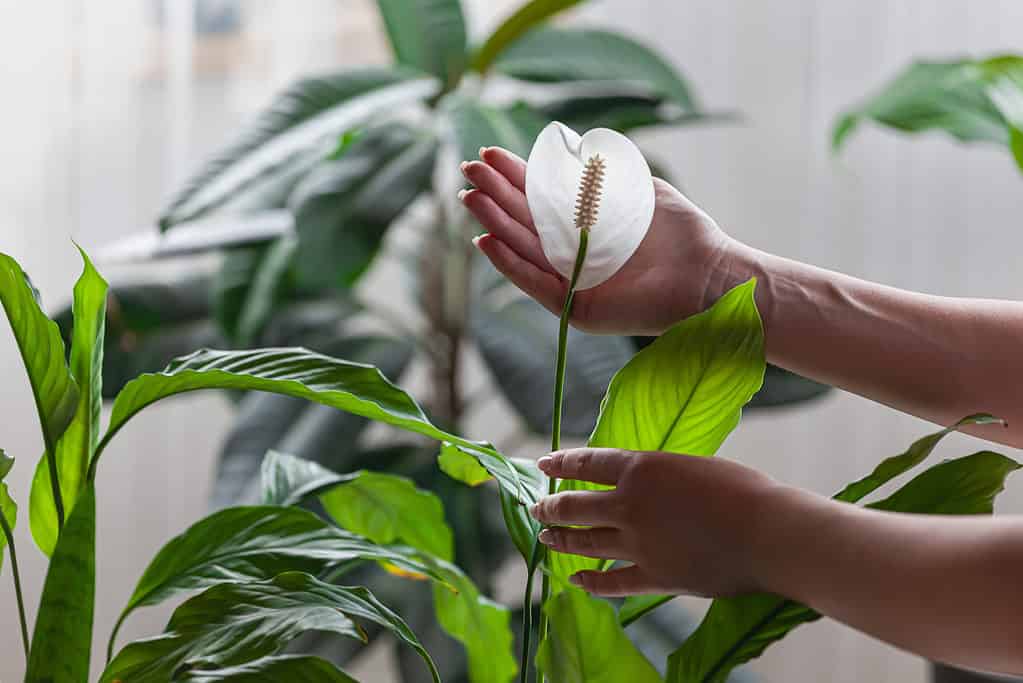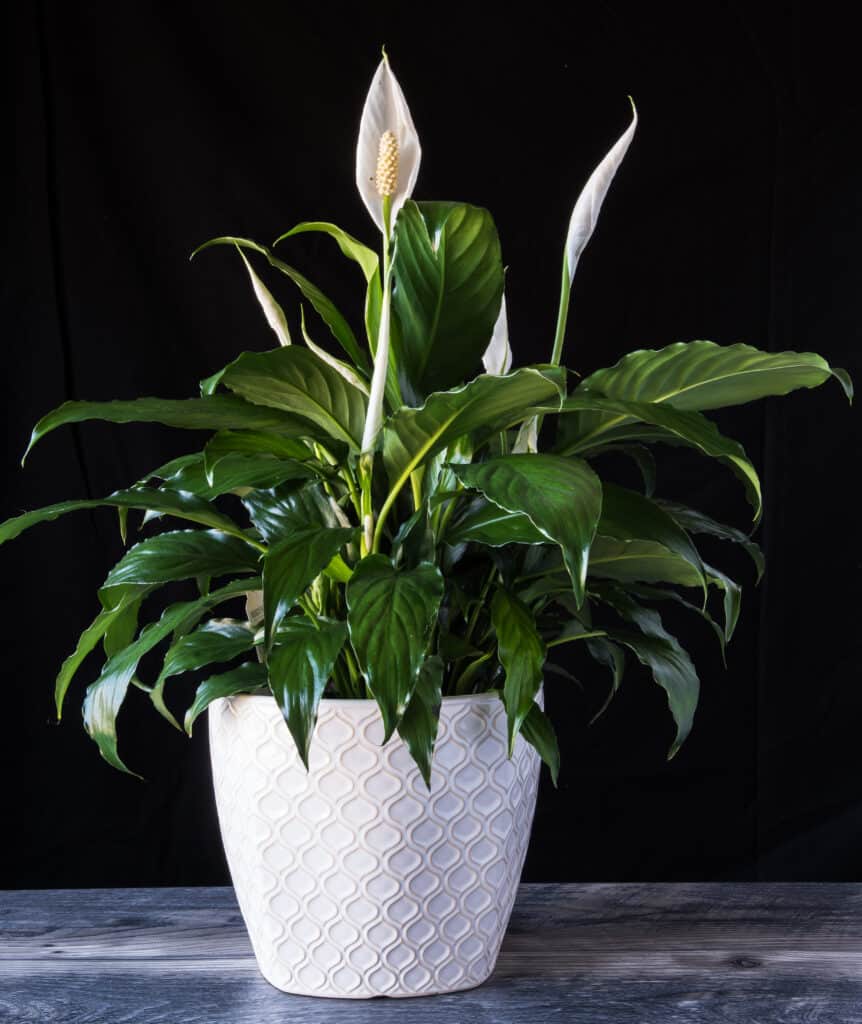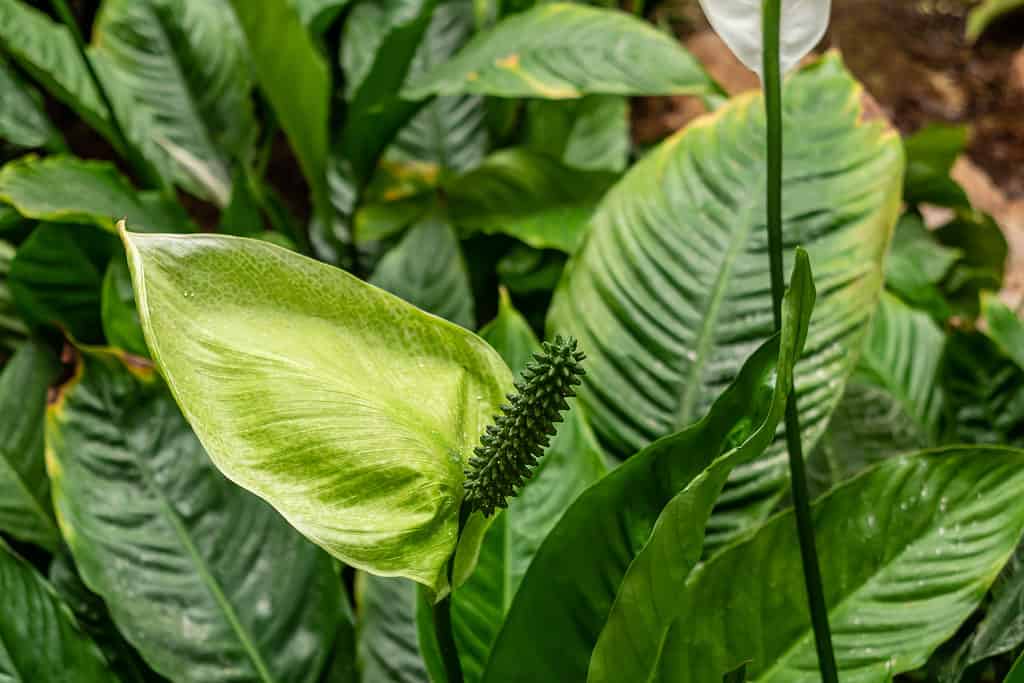Peace lilies, which are plants under the Spathiphyllum genus, are such well-liked indoor plants. They can survive low light levels and are rarely bothered by illnesses and pests. When they are dehydrated, they wilt noticeably, making it hard for you to ignore them for an extended period of time. You may definitely think of them as the ideal home plant when you take into account their stunning foliage, sturdy form, and spectacular white flower and spathe structures.
However, you’ll find that not all peace lilies are the same once you start researching them. Peace lilies are found in roughly 47 species and 100 distinct varieties. Both little tabletop specimens and six-foot giants can fall under these varieties. A variety with variegated leaves, as well as those with chartreuse or blue-green leaves, are also potential options. You can discover plants with lots of tiny, delicate blooms or some with spathes as big as your palm if you like them for their floral architecture.
Instead of the usual white flower spathes, you can encounter Spathiphyllum plants for sale with reddish, blue, or yellow flower spathes. They are not naturally this hue. To generate attention and hasten sales, they have been colored in these unique colors using plant dye. While very fun, bear in mind that when you take one of these peace lilies home, future blossoms will be white. Peace lilies have white or greenish-white spathes naturally.
With this information in mind, let’s take a look at some of the most popular peace lily varieties out there, so you can make a more informed decision about the plant you plan on taking home.
Peace Lily Cultivars
There are many types of peace lilies out there. Some of them have very little variation from the native plant, while others can look quite different from the traditional peace lily. However, all of these varieties can be grown indoors fairly easily.
Spathiphyllum wallisii
Height: Up to 15 inches, though it can grow larger in ideal conditions
Spread: 15 inches or wider
Description: This peace lily is a species, rather than a variety of a species. It is the most popular type of indoor peace lily and has several varieties within the species itself. Spathiphyllum wallisii is named after Guztav Wallis, a collector for Chelsea, England’s William Bull Nursery. When mature, the lanceolate, dark green leaves of this kind of peace lily have a glossy or lustrous sheen. There are leaves that may be found that are 14 inches long and 4 inches broad. Usually measuring around seven inches long and three inches broad, the spathe of this peace lily. This peace lily is considered a dwarf species.

The
Spathiphyllum wallisiispecies (pictured) is considered a classic type of peace lily.
©iStock.com/perfectlab
Spathiphyllum ‘Allison’
Height: Up to 24 inches
Spread: Varies
Description: One of the most well-liked peace lily varieties is Spathiphyllum ‘Allison. It features a medium-sized set of dark green leaves. You will be astounded by their distinctively hooded, white blossoms and hardiness as you are by other peace lily varieties. They require little upkeep and thrive in hydroponic systems.
Spathiphyllum ‘Golden’
Height: Up to nine inches
Spread: Up to six inches
Description: One uncommon indoor blooming plant is the ‘Golden’ peace lily. It is a particularly well-liked variant for indoor air purification. Its blossoms are distinctive among peace lilies because they have a snake-like appearance. If you examine their leaves, you’ll see that they are glossy and shining with no spathes, and they are a golden tint. The lower parts of this plant first bloom in a light green color before becoming creamy white.
Spathiphyllum ‘Sensation’
Height: Four feet, though it can reach six feet in some cases
Spread: Up to three feet
Description: The ‘Sensation’ peace lily is an evergreen plant with large, elliptical, dark green leaves that can develop in layers. When fully grown, the stalk is 20 inches tall and its white bloom may grow up to four inches wide. When fully grown, this perennial peace lily variety may reach a height of around three feet, making it one of the bigger varieties. This cultivar is ideal for parks and gardens, but it’s also good for growing in containers or inside.
Spathiphyllum ‘Petite’
Height: Up to 18 inches
Spread: Up to 12 inches
Description: The ‘Petite’ peace lily, a dwarf variety that is native to Southeast Asia, can reach a height of around 18 inches. It has attractive foliage that is glossy, dark green, and has a pointed tip to its leaves. The ‘Petite’ peace lily may be distinguished from other varieties thanks to the white spathe and spadix of this variety. They look to be more teardrop-shaped, and tend to stay a more creamy-white color.

The ‘Petite’ peace lily (pictured) rarely grows taller and wider than a foot, making it idea for potting.
©Simone O/Shutterstock.com
Spathiphyllum ‘Mojo’
Height: Up to 16 inches
Spread: Up to 16 inches
Description: Spathiphyllum ‘Mojo’ is a terrific indoor variety of peace lily. This attractive plant will enliven any space or shaded gathering place when it is in bloom. Together with the many flowers of beautiful milky white that they accompany, the lush and dark green leaves have a satin-like look. This could be a wonderful addition to your collection of plants at home, in the garden, or at the office. With little upkeep needed, Spathiphyllum ‘Mojo’ is incredibly simple to cultivate and consistently looks excellent with minimal care. It consistently blooms and is well-liked by florists. This peace lily cultivar, like many others, is an excellent oxygenator. It grows a little bit more quickly than other types.
Spathiphyllum ‘Domino’
Height: Up to two feet
Spread: Up to four feet
Description: A special variety of the common peace lily is called the ‘Domino’ peace lily. Its ease of growth makes it one of the greatest indoor plants for beginners. The leaves of this plant have marbling patterns of rich green. You may put them in the living room, bedroom, or office to create relaxing and elegant atmosphere. In order to hasten the flowering of this variety, place them in indirect bright light.

The
Spathiphyllum‘Domino’ (pictured) has variegated leaves with marbling.
©iStock.com/JOSE LUIS VEGA GARCIA
Spathiphyllum ‘Patricia’
Height: Up to 12 inches
Spread: Varies
Description: The small ‘Patricia’ variety has lush green foliage and white blooms with light yellow centers. The contrast between the white blossoms and the deep green foliage of this small variety add a delightful, delicate touch to the aesthetics of an indoor space. This variety tends to not grow very full leaves, so keep that in mind if you’re looking for a fluffier, more voluminous plant.
Spathiphyllum ‘Bongo Bongo’
Height: Up to 20 inches
Spread: Up to 16 inches
Description: You will like the ‘Bongo Bongo’ peace lily if you wish to receive wonderful leaves from your plant. The spread of this cultivar is 20 inches high and 16 inches broad. Like the majority of peace lilies, it prefers shade or moderate sunshine. However, you must make sure this variety gets its partial sunshine if you want it to produce its trademark large leaves. The naturally glossy, thick, dark-green leaves feature deep veins that are well-delineated, which adds to the plant’s overall symmetrical beauty.
Spathiphyllum ‘Sweet Rocco’
Height: Up to 20 inches
Spread: Up to 20 inches
Description: The gorgeous indoor plant Spathiphyllum ‘Sweet Rocco’ has huge, paddle-shaped white blooms with a golden spike center that dangle above the compact, glossy foliage. This variety flowers year-round if conditions are right, and it blooms far more than other Spathiphyllum varieties do. This selection will bring a dash of beauty to any patio pot, courtyard, or container. This variety should be placed in areas with low to moderate light, especially filtered indoor light.
Do Peace Lilies Need Sun or Shade?
Peace lilies, like the majority of plants, require some sunshine to continue growing. Although they won’t require much of it, they will require more than nothing. Try to choose a location in your office or home where the plant will receive some indirect sunlight every day for a few hours. If it gets access to indirect, bright sunshine with dappled shade, it will grow better. As long as the plant receives some sunshine, you may keep it in low light. Make sure the plant has access to some light throughout the day while shielding it from direct sunshine.

The peace lily (pictured) can be toxic to pets, so they should be kept near a high window or on a shelf.
©iStock.com/Anya Why
Are Peace Lilies Toxic for Pets?
Thankfully, peace lilies don’t pose the same threat as Lilium or Hermocallis lilies. Peace lilies are actually not closely related to true lilies, which are extremely poisonous to cats. But, peace lilies can still cause damage if a cat or dog eats a piece of the plant or chews on it.
Insoluble oxalates are minute needle-like crystals that are present in every section of the peace lily. These parts of the plant immediately burn the mouth and tongue when they come into touch with them. Drooling, excessive mouth-licking, mouth-pawing, vomiting, trouble swallowing, or discomfort when swallowing are all possible outcomes. While they aren’t deadly, they can still be dangerous, so keep your peace lily out of reach of pets.
How to Propagate Peace Lilies
A peace lily may be propagated easily by cutting up the mother plant into smaller pieces. The number of plants you split and develop is entirely up to you, albeit it will depend on the size of the plant and the number of crowns it has.
Leaning the plant to one side will help you remove your mother plant from its current container. Keep all of the leaves together, if possible. The majority of the time, pressing the pot’s side will release a trapped plant.
Start splitting up your plant. The peace lily plant can be divided by carefully removing a part of the crown from the mother plant by hand, or by cutting sections away with a sharp knife. To be properly propagated, the crown must have roots connected and at least two leaves.
You’ll then have a variety of plants, including the mother plant, that you’ll need to get ready for potting up. Remove any loose roots or leaves with brown tips after inspecting the roots and foliage.
You’re now prepared to pot your propagated plants! When potting up, four-inch pots work well. A peat-based potting mix should be used to fill the pots. You won’t need to water the plant if the soil is already quite moist. If the soil is dry, give it a good dose of water. That’s all it takes!
With all of these excellent peace lily varieties, you can definitely find the right plant for your space. Keep in mind that even though this plant is low maintenance, it will still need some attention to ensure that it grows at its best. And once your plant grows large, you can propagate it into smaller plants. How fun is that?
Want to learn even more about this amazing plant? Check out our complete guide to peace lilies here.
Up Next:
- 10 Bathroom Plants That Absorb Moisture
- 6 House Plants That Purify The Air
- Are Lilies Poisonous To Dogs Or Cats?
The photo featured at the top of this post is © iStock.com/Olga Chuprina
Sources
- NCSU Staff, Available here: https://plants.ces.ncsu.edu/plants/spathiphyllum/
- Daniel Iseli, Available here: https://plantophiles.com/plant-care/peace-lily/
- Balcony Garden Web Staff, Available here: https://balconygardenweb.com/types-of-peace-lily-spathiphyllum-varieties/
FAQs (Frequently Asked Questions)
How many varieties of peace lily are there?
There are 40 different species of peace lilies and over 100 different varieties of spathiphyllum genus plants.
Which peace lily is the best for growing at home?
There are many great peace lilies out there for growing indoors. A few examples include the Piccolino peace lily, the Patricia peace lily, and the white stripe peace lily.
Do peace lilies only bloom once?
No. Peace lilies can bloom throughout the year, if they are kept in the right conditions.
Thank you for reading! Have some feedback for us? Contact the AZ Animals editorial team.






